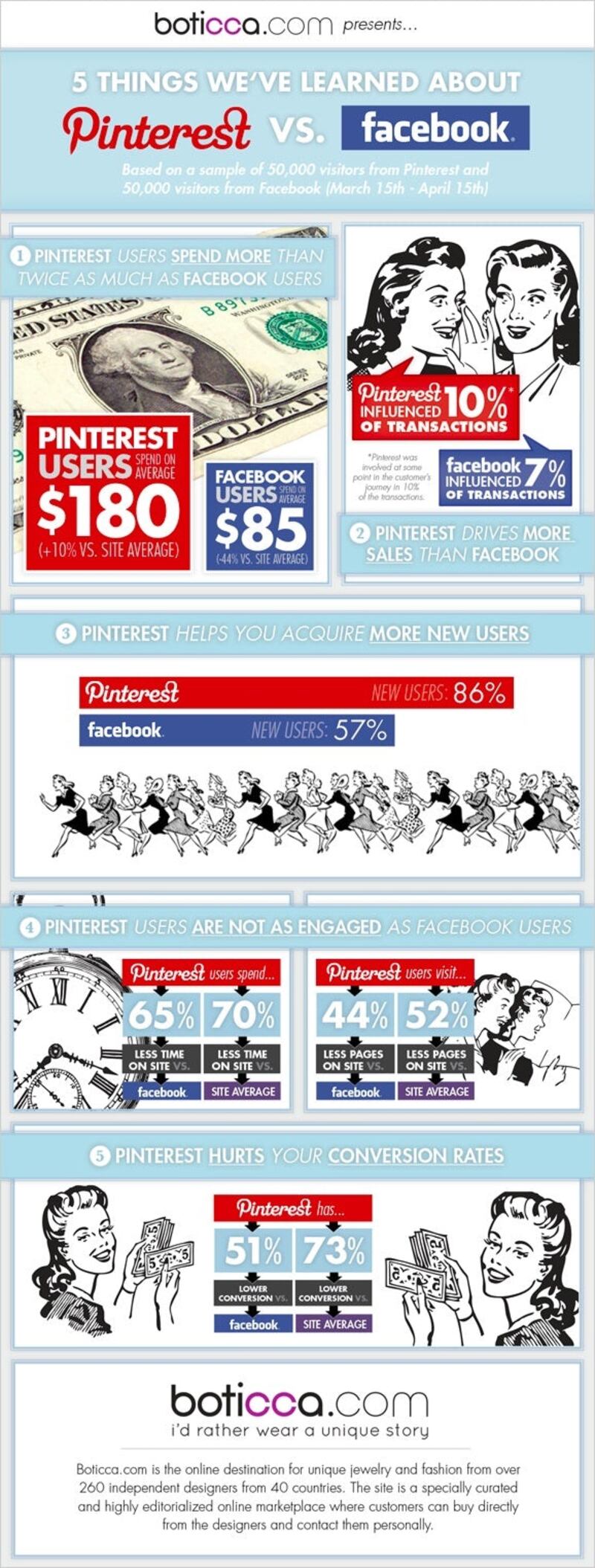
The Business of Fashion
Agenda-setting intelligence, analysis and advice for the global fashion community.

Agenda-setting intelligence, analysis and advice for the global fashion community.

LONDON, United Kingdom — It's now common knowledge that social curation site Pinterest — which attracted its first 10 million users faster than any other website in history — is the fastest growing social platform today, with 18.7 million users as of March, according to comScore. But what does this mean for social giant Facebook, fashion businesses and the bottom line?
According to research provided exclusively to BoF, it turns out that the answers to these questions are mixed. A case study by online boutique Boticca.com shows that Pinterest users buy and spend more than their Facebook counterparts, but that their levels of engagement are considerably lower.
London-based Boticca is a curated online marketplace that specialises in accessories and jewelry. Founded by Kiyan Foroughi and Avid Larizadeh, the company was early to integrate Pinterest across its website, a move that has already paid off. Indeed, in the last month, Pinterest has become the site’s primary social media driver in terms of sales, begging the question: when it comes to social commerce, which is the bigger player: Facebook or Pinterest?
According to the Boticca study, based on data that was gathered last month, Pinterest drives more sales than Facebook and attracts more new users. The results show that 10 percent of all transactions came from users who arrived at the site via Pinterest, compared to 7 percent for Facebook. And while 86 percent of users who came via Pinterest were visiting Boticca for the first time, only 57 percent of traffic from Facebook was composed of new users. The numbers also indicated that Pinterest users are willing to spend more than their Facebook counterparts. Indeed, their purchases totaled more than twice as much on average per transaction.
ADVERTISEMENT
Facebook channels a more captive audience, however. According to the Boticca data, Pinterest users spend 65 percent less time on the retailer’s website than those that come from Facebook and 70 percent less than the site’s average. Not surprisingly, the Pinterest bounce rate is higher as well – 43 percent more than Facebook – and conversion rates are the lowest of any channel.
So what accounts for these behaviours?
With its highly visual mood boards and social curation model, Pinterest is all about discovery and replicates an experience similar to window-shopping. Popular categories on the site, like home decor, mens and womens apparel, and food and drink have become powerful places for brands to contextualise their products and build awareness through recommendations. Furthermore, Pinterest’s simplified navigation tools and seamless product links make it easy to convert ‘pins’ into sales. But an average of only 14.2 minutes per visit per user shows that Pinterest traffic is more ephemeral and users are less likely to linger on a product.
Facebook on the other hand has a much more engaged audience. Users browsing company pages interact with the brand in a more controlled setting, exploring layers of products, promotions and marketing material. And Facebook users take their time. A recent comScore study on Pinterest indicates that average time on site per visitor hit about 98 minutes per month in January of 2012. But in comparison, Facebook users currently spend about 7 hours per month on the platform. And with more than 900 million users, the Facebook opportunity is massive in terms of sheer scale.
So why have businesses been so hesitant to embrace so-called 'F-Commerce', enabling users to shop directly from the Facebook platform? After the launch of much buzzed about experiments in F-Commerce, many high profile retailers have begun to retreat. Indeed, brands like Gap, JCPenny and Nordstrom shuttered their Facebook storefronts last year. In an interview with Bloomberg, Sucharita Mulpuru, an analyst at Forrester Research, commented: "There was a lot of anticipation that Facebook would turn into a new destination, a store, a place where people would shop. But it was like trying to sell stuff to people while they're hanging out with their friends at the bar."
It would seem that while Facebook users turn to the platform primarily for conversation and personal connection, in contrast, the mindset of typical Pinterest users is much more geared towards browsing products and, ultimately, shopping.
The Bottom Line
Pinterest appears to be outpacing Facebook in the social commerce race. This is due in part to the way that people experience Pinterest, the nature of the content it features, and the power of its tastemakers. But Facebook isn’t out of the game yet. With its extensive network and unparalleled level of user engagement, Facebook remains one of the most powerful marketing opportunities available. If Facebook is able to recalibrate its F-Commerce model and entice users to shop in the same place where they “hang out with their friends at the bar,” they may be able to convert the social network into a solid consumer base.

From analysis of the global fashion and beauty industries to career and personal advice, BoF’s founder and CEO, Imran Amed, will be answering your questions on Sunday, February 18, 2024 during London Fashion Week.
The State of Fashion 2024 breaks down the 10 themes that will define the industry in the year ahead.
Imran Amed reviews the most important fashion stories of the year and shares his predictions on what this means for the industry in 2024.
After three days of inspiring talks, guests closed out BoF’s gathering for big thinkers with a black tie gala followed by an intimate performance from Rita Ora — guest starring Billy Porter.